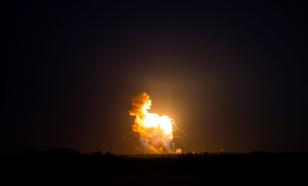Russia launches second super heavy Angara A5 space rocket in 6 years
The "Angara-A5" heavy space rocket blasted off from the Plesetsk cosmodrome of the Russian Ministry of Defense in the Arkhangelsk region on Monday, December 14, at 08:50 Moscow time. The rocket is to deliver nearly 2.5 tons of cargo into geostationary orbit. Reportedly, the cargo is of no practical use.
The launch was the second for the Angara-A5 and the third for the Angara rockets. The first and only launch of the light "Angara-1.2 rocket took place on July 9, 2014 from Plesetsk. The rocket flew on the ballistic trajectory to the area of the Kura range ground in Kamchatka. The flight lasted for 21 minutes, during which the carrier, together with an undetachable model weighing 1.43 tons, covered 5,700 kilometers.
The first launch of "Angara-A5" with the upper stage "Briz-M" and a cargo model weighing 2 tons took place on December 23 of the same year, also from Plesetsk.
In November, a source in the Russian rocket and space industry told TASS news agency that there was understated insulation resistance between the second and third blocks was detected at the Angara-A5, which had already been delivered to the launch pad by that time. The rocket was subsequently removed from the site, and its launch was postponed to December.
- The problem had not been identified during all the inspections and checks preceding the installation of the rocket on the launch pad.
- In August, Roscosmos chief Dmitry Rogozin, during his report to Deputy Prime Minister Yuri Borisov at Army-2020 forum, promised that the rocket would be launched into space in November.
- Angara-A5 launches are postponed regularly. In August 2018, Rogozin stated that flight tests of the Angara rockets would continue in 2019.
In March, it was announced that Angara-A5 would undergo modernization. When visiting the Polyot Production Association (Omsk branch of the Khrunichev Center) Rogozin said that it had been decided to decrease the weight of the new rocket and increase its thrust-to-weight ratio. In particular, the new Angara-A5M should be distinguished from Angara-A5 by the modernized RD-191M engine of enhanced carrying capacity.
According to the financial report of the Khrunichev Center for 2019, which was published in June, the cost of production of Angara-A5 is seven billion rubles, which is three times more expensive than the heavy Proton-M rocket, which Angara is meant to replace. In May 2019, based on the data from SPARK-Marketing system, it became known that the Angara-1.2 light rocket was 1.5 times more expensive than the average Soyuz-2.1a and Soyuz-2.1b carrier rockets. In July, former general director and ex-designer of the Khrunichev Center, Vladimir Nesterov, tried to explain the causes behind the high cost of the Angara-A5 space rocket:
"Wages, electricity, gas, heat, extra costs, transportation services have to be included somewhere. When the three-fold manufacturing cycle is attributed to one product, naturally, its price triples."
In 2012, General of the Army in reserve Vladimir Popovkin evaluated the funds that had been spent on the development of the Angara space rocket at $5.33 billion.
Russia's first and now deceased President Boris Yeltsin signed the order to start the works on the Angara space rockets family on January 6, 1995. The work plan for the project, approved by the government decree on August 26, 1995, provided that the rocket would be ready for space flight by 2005.
Russia started working on the new Angara rocket (the rocket is developed by the Khrunichev Center) almost at the same time when the United States started working on Atlas V and Delta IV heavy carriers (their operation is to be completed in the first half of the 2020s). The USA either has replaced or is in the process of replacing heavy disposable carrier rockets with reusable Falcon 9, Falcon Heavy, New Glenn and Vulcan carriers (in the future). The USA also works on the fully reusable Starship transport system.
The Khrunichev Center still works on the oxygen-hydrogen heavy upper stage: the works on the project started in 2009, but no flight model has been built to date.
Subscribe to Pravda.Ru Telegram channel, Facebook, RSS!


